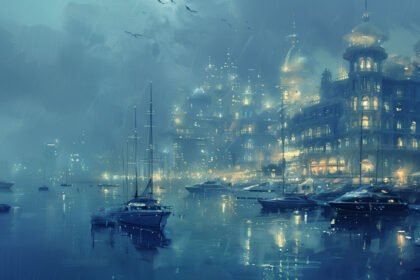“Marina’s Monster” is a dark, psychological horror story set in the eerie district of Mirage Marina in DangerCity. The protagonist, Cassandra, is a complex character whose internal struggle between sanity and madness forms the crux of the narrative. The story goes into themes of exploitation, transformation, and the blurred lines between reality and delusion, creating a compelling and unsettling tale.
Marina’s Monster | Plot Summary
Cassandra, a 20-year-old woman, once worked in the casino of Mirage Marina. Her disillusionment with humanity and the constant harassment she faced led to violent outbursts. After being caught manipulating odds when touched by patrons, she was demoted to an exotic dancer, performing while tied to a pole to prevent her from attacking the guests. This forced role only deepened her resentment and desire for escape.
Drawn to the legends of monsters lurking in the waters of Mirage Marina, Cassandra believes she has a special connection with these creatures, particularly a mutated eel affected by pollution and biological testing from the Core. The eel, a terrifying amalgamation of aquatic and terrestrial horror, symbolizes the darker aspects of human nature and the consequences of environmental degradation.
One night, after being harassed by two men from the Core, Cassandra retaliates with lethal force, feeding their bodies to the monster she believes to be her ally. This act of violence marks her descent into madness or, perhaps, her transformation into something more powerful and primal. Her father, aware of her violent tendencies and the danger she poses, confronts her, but Cassandra is unwavering in her belief that she is becoming a monster, destined to rise from the water and claim her true identity.
Themes and Symbolism
- Transformation and Identity: Cassandra’s yearning to become a monster symbolizes her desire to escape her current life and transform into something powerful and uncontrollable. This transformation represents her rebellion against the societal norms that seek to objectify and limit her.
- Madness vs. Reality: The story constantly blurs the line between Cassandra’s sanity and madness. Her belief in the monsters and her transformation questions whether she is truly becoming something otherworldly or if she is simply losing her grip on reality. This ambiguity serves to highlight the psychological impact of her environment and the trauma she has experienced.
- Exploitation and Autonomy: Cassandra’s role as an exotic dancer, tied to a pole to prevent her from attacking patrons, symbolizes the extreme control and exploitation she endures. Her violent responses to harassment and her eventual rebellion against her father and the casino’s patrons represent her struggle for autonomy and self-definition.
- The Monster as a Metaphor: The mutated eel in the story represents the darker aspects of human nature and the consequences of environmental degradation. The creature’s need to feed parallels Cassandra’s own hunger for power and revenge against those who have wronged her. It also serves as a reminder of how humanity’s actions can create real monsters, both literal and figurative.
- Power Dynamics and Revenge: Cassandra’s violent actions against the men who harass her and her father’s complicity in her exploitation highlight the power dynamics at play. Her transformation into a monster, whether real or imagined, becomes a form of revenge and reclamation of power in a world that seeks to suppress her.
Greek Mythology Connection
The name Cassandra is significant. In Greek mythology, Cassandra was a priestess cursed to utter true prophecies that were never believed. This parallel is evident in Cassandra’s story; she warns of the monsters and her transformation, but no one believes her, dismissing her as insane. This element adds depth to her character, raising questions about belief, truth, and perception.
Conclusion
“Marina’s Monster” is a gripping exploration of a young woman’s struggle against exploitation and her quest for identity in a world that constantly seeks to diminish her. The story’s ambiguity—whether Cassandra is truly becoming a monster or is simply mad—creates a compelling narrative that challenges readers to question the nature of reality and the power of belief. Through Cassandra’s eyes, we see a reflection of our own darkest fears and desires, making “Marina’s Monster” a haunting and thought-provoking tale.
















